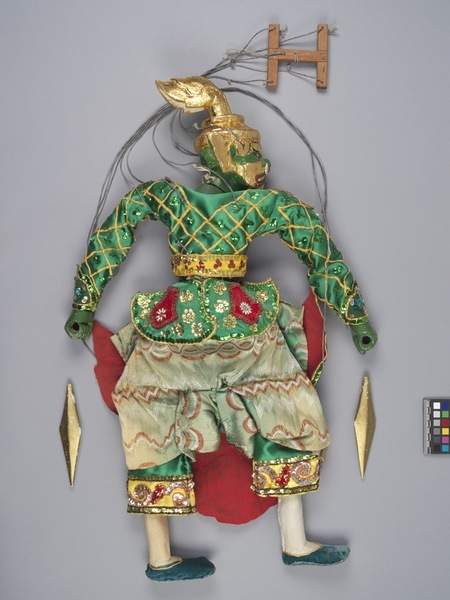String Puppet Item Number: 3307/2 a-c from the MOA: University of British Columbia


Description
String puppet (marionette) of the character taw belu (jungle ogre), the man-eating ogre or demon. The figure has green skin, wears a gold helmet, and has large fangs protruding from the mouth. Both hands are clenched with an opening through the centre to insert something for the figure to hold. The figure wears a shiny green top with thin strips of plaited gold cord crossing overtop. The pants are embroidered with designs in orange, white and yellow-green. The outfit is further embellished with fabric cut-outs decorated with sequins, beads and plaited cord. The figure wears blue velvet slippers. There are also two (separate) diamond-shaped, wooden daggers (parts b-c) painted gold.
History Of Use
Yoke thé, the string puppet or marionette theatre of Myanmar (Burma), originated in 1780, during the reign of King Singu Min, under the guidance of U Thaw, his minister for the performing arts. Plays begin with the creation of the world and the second part consists of episodes of the Jataka Tales (a Buddhist text) or from local folklore. Richly embellished, attired and stringed, there are 28 stock characters, consisting of human characters, supernatural beings, familiar animals, and fantastic creatures. These may include the White Horse (myin), the green-faced Jungle Ogre (Taw Belu), the City Ogre (Nan Belu), the mythological bird (Garuda), the monkey, the snake (Naga), the magician Zawgyi, a page boy, the King, Prince, and the Princess (from Shadows, Strings & Other Things, 2019). The White Horse (myin) and the green-faced Jungle Ogre (Taw Belu) appear at the beginning of the play to perform the energetic Creation of the World. The White Horse (see 3307/1) descends, prancing and rearing its agile body, alone on the stage, conjuring a spiritual force and dancing the world into being. In contrast, Jungle Ogre (Taw Belu), this object, battles the City Ogre (Nan Belu) in a highly choreographed and menacing display of evil and aggression. They show their fangs and fight hand-to-hand with their golden daggers. The victor is always City Ogre (Nan Belu).
Narrative
This puppet was part of a puppet show seen by the donor when she was in Yangon in 1995. After the show she asked the puppeteers if they knew of a place where she might be able to purchase puppets like theirs, and they decided to sell her the ones from their performance.
Item History
What
Where
- Holding Institution
- MOA: University of British Columbia
- Made in
- “Myanmar: Rangoon” ?
When
- Creation Date
- before 1995
- Collection Date
- during 1995
- Ownership Date
- before July 26, 2018
- Acquisition Date
- on July 26, 2018
Other
- Condition
- fair
- Accession Number
- 3307/0002 a-c